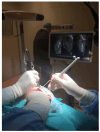CT Navigation-Assisted Transfacial Removal of Parotid Stones: Does It Work?
- PMID: 40217787
- PMCID: PMC11989844
- DOI: 10.3390/jcm14072338
CT Navigation-Assisted Transfacial Removal of Parotid Stones: Does It Work?
Abstract
Background/Objectives: The failure rate of minimally invasive surgical approaches to parotid stones is about 10%, primarily due to the presence of large, impacted, or unpalpable deep stones. When stones are palpable and exceed 7 mm in size, a combined transfacial and sialendoscopic approach offers a safe and effective surgical option, while unpalpable and impacted stones located in the parenchyma, not visible or accessible through sialendoscopy, can be treated with a CT-guided transfacial approach. Methods: Twenty-two patients (three females, mean age 53 years, range 32-73 years) underwent CT navigation-assisted transfacial removal of unpalpable and impacted parotid stones at the Department of Otolaryngology and Head and Neck Surgery of Fondazione IRCCS Ca' Granda Ospedale Maggiore Policlinico of Milan between 2017 and 2024. Results: The mean size of the stones was 7.4 mm (range 4-14 mm), while the mean depth of stones, calculated as the distance from the skin surface, was 8.7 mm (range 4-14 mm). Stones were removed successfully in all but five patients (77% success rate). Failure of the procedure was significantly associated (p < 0.05) with the depth of the stone (>12 mm); in all these cases, patients were treated immediately by means of traditional parotidectomy. Conclusions: The CT-navigation-assisted transfacial approach can be considered a safe, reliable, and efficacious option for the treatment of difficult unpalpable parotid stones, impacted and deeply located in the gland parenchyma. Stones deeper than 10 mm can be more effectively treated by means of traditional parotidectomy if extracorporeal lithotripsy is not available.
Keywords: CT navigation assisted; endoscopy assisted; minimally invasive technique; parotid stones; sialolithiasis.
Conflict of interest statement
The authors declare no conflicts of interest.
Figures





Similar articles
-
Sialendoscopy-assisted transfacial surgical removal of parotid stones.J Craniomaxillofac Surg. 2014 Dec;42(8):1964-9. doi: 10.1016/j.jcms.2014.08.009. Epub 2014 Sep 7. J Craniomaxillofac Surg. 2014. PMID: 25441870
-
Cost-effectiveness of transfacial gland-preserving removal of parotid sialoliths.Laryngoscope. 2017 May;127(5):1080-1086. doi: 10.1002/lary.26342. Epub 2016 Nov 22. Laryngoscope. 2017. PMID: 27873327 Free PMC article.
-
Laser-Assisted Lithotripsy With Sialendoscopy: Systematic Review of YO-IFOS Head and Neck Study Group.Ear Nose Throat J. 2021 Feb;100(1_suppl):42S-50S. doi: 10.1177/0145561320926281. Epub 2020 May 22. Ear Nose Throat J. 2021. PMID: 32442031
-
Salivary lithotripsy in the era of sialendoscopy.Acta Otorhinolaryngol Ital. 2017 Apr;37(2):113-121. doi: 10.14639/0392-100X-1600. Acta Otorhinolaryngol Ital. 2017. PMID: 28516973 Free PMC article. Review.
References
-
- Koch M., Schapher M., Mantsopoulos K., von Scotti F., Goncalves M., Iro H. Multimodal treatment in difficult sialolithiasis: Role of extracorporeal shock-wave lithotripsy and intraductal pneumatic lithotripsy. Laryngoscope. 2018;128:E332–E338. - PubMed
-
- Nahlieli O., London D., Zagury A., Eliav E. Combined approach to impacted parotid stones. J. Oral Maxillofac. Surg. 2002;60:1418–1423. - PubMed

